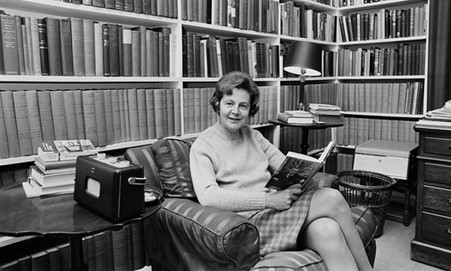As we commemorate our 100th year, we have taken the chance to look back at the numerous influential individuals who have shaped the history of our organization. We want to take a moment to highlight key figures and applaud the remarkable contributions they have made not only to HB&P/AMS, but also the lasting impact they have had in the broader heritage sector. The first of these individuals is Dame Jennifer Jenkins.

Dame Jennifer Jenkins (1945-2017)
By Matthew Saunders
Dame Jennifer Jenkins was both Secretary and President of the AMS . Jennifer, wife of Roy Jenkins M.P., Home Secretary and Chancellor of the Exchequer, and often touted as one of the “best Prime Ministers that we never had”, was a hugely significant public figure in her own right. Having made her name in The Consumers Association (where she was Chair, 1965-76), she was “head-hunted” by the dominant man in the life of the AMS, Ivor Bulmer-Thomas, to be AMS Secretary in the 1972. The Jenkins and Bulmer Thomases had been very close through shared Welsh roots, the common platform of an intellectually transforming Oxford education and the conscious purchase of country cottages within a few miles of each other. It was Roy Jenkins who gave the eulogy by Ivor’s grave side. Jennifer threw herself into lending the AMS esteem and clout.
For three years the office was based in her spare bedroom – Matthew Saunders, appointed Casework Secretary in 1976, banged away on a typewriter from the Stone Age with a view of the gardens in Ladbroke Square, and became witness to events on the national stage – when the Press door-stepped Roy at No 33, as President of the EU, after James Callaghan had refused him access to a London-based European Summit and when the police lent the AMS office extra cover. This was the time when the Price Sisters were starving themselves to death; Roy was Home Secretary and the IRA were threatening revenge if they died. As Jennifer arrived, the AMS was a fledgling National Amenity Society and she taught it how to consolidate and expand its newly-acquired rights to be consulted whenever a listed building came under threat. An incredible 600 listed buildings were menaced by applications for total demolition each year in the late seventies. Laura Grenfell and Magda Russell and then Matthew Saunders really had their work cut out and Jennifer’s calm but steely and astute determination lent a loose-rein but supportive framework.
She had a particular passion for that comparatively new invention, the Conservation Area, and commissioned on behalf of the AMS a series of pioneering reports on how given Areas might be designated and, once designated, safeguarded and improved. It was inevitable that the authorities spied talent when they saw it and after being with the AMS as Secretary for some five years, she was enticed into a career path with a trajectory that trailed clouds of glory – from Chair of the Historic Buildings Council for England, a post in fact she took whilst still at the AMS in 1975 (she was there at the establishment of English Heritage, even if pipped at the post as Chair by Lord Montagu).
From 1985 to 1990 she was Chair of the National Trust (a substantial history of which she was later to write). By that stage, we had persuaded her to be our President (in 1985) and it was a joy when the announcement of her Dame-hood in that year was announced on the self-same day that she chaired our AGM. Well into her seventies, she became a significant player at The Heritage Lottery Fund after that had been established in 1995. She championed one of the most innovative of HLF’s programmes – that for Urban Parks and for a time chaired their Expert Panel. Public service was in her blood – she and Roy met at the Oxford Fabian Club . Her father, Sir Parker Morris, was City Clerk at Westminster and gave his name to the generous standards for the internal planning of Council Houses that he drew up.


